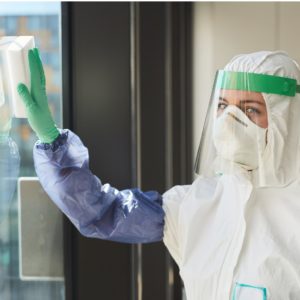Interventional Care


We notice that you are visiting us from . This site only services US-based visitors. Would you like to visit the site that is appropriate for your location?

Last May, Kevin Tyan and Dr. Pieter Cohen from Harvard Medical School and Cambridge Health Alliance, respectively, published an article in the Annals of Internal Medicine entitled: “Investing in Our First Line of Defense: Environmental Services Workers.”¹ Almost one year has passed since then, and the COVID-19 pandemic continues to march on, possibly entering the fourth wave in the surge of new cases here in the USA.
It is appropriate to reinvest our support of these hundreds of thousands of essential environmental services (EVS) personnel devoted to cleaning and disinfecting our hospitals and long-term care (LTC) facilities. These EVS workers are the most essential to combating the spread of the virus within the facilities they serve but are also the group most likely to be exposed to the virus. These unsung heroes have faced multiple challenges performing their arduous tasks of cleaning and disinfecting multiple surfaces and equipment with even greater efficiency and diligence than ever before. Pre-pandemic, a once per day cleaning of rooms was the norm, and possibly less frequently in long-term care resident rooms. With the advent of the pandemic, they have been called to increase the frequency of cleaning/disinfection up to three times per day – a 300% increase in workload and often without additional staff/support.
Furthermore, their devotion to patient/staff safety has been hindered by personal protective equipment (PPE) shortages, germicides placed on allocation/back-order, and ongoing work fatigue due to long hours, as well as anxiety about being exposed to SARS-CoV-2 and possibly bringing it home to family members.
Keeping pace with these challenges is a daunting task, especially with changes in germicide occurring almost weekly with different instructions for use and wet contact times while ensuring it is on the EPA’s List N of approved disinfectants for COVID-19.
With the advent of having two mRNA vaccines and a third viral vector vaccine under FDA emergency use authorization (EUA) available, the priority is to have these EVS workers fully vaccinated as soon as possible. However, there is often hesitancy that prevents them from pursuing vaccination.
As Tyan and Cohen mentioned in their article¹, a culture of urgency and responsibility needs to be instilled in every employee working in these healthcare settings. It begins with showing respect/admiration for the EVS staff and taking steps to support their efforts on the frontline of infection prevention., as well as by acknowledging their role as valuable members of the patient care team. Rather than being a target for cost-cutting efforts when lay-offs loom over their heads, these team members should be viewed as a core critical investment in improving patient outcomes.
The strategies to support EVS workers were distilled to four key goals by Tyan & Cohen¹:
Healthcare will be forever changed after the global pandemic, and no doubt, EVS personnel will continue to play an essential role in infection prevention. By providing the proper tools, novel no-touch technology, continuously active disinfection technology, ongoing education/training, greater access to vaccine and PPE, we can create a new generation of dedicated EVS workers that even extends into public settings, including schools, sports stadiums, travel venues (e.g., buses, trains, airplanes), cruise ships, amusement parks, conference centers, and the list goes on.
Now is an appropriate time to shine a new light on these unsung heroes and acknowledge their patient/LTC resident safety role.
¹ K. Tyan and P.A. Cohen. Investing in Our First Line of Defense: Environmental Services Workers. AIM, vol. 173, no. 4. 18 Aug. 2020, pp. 306-308.